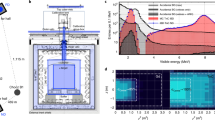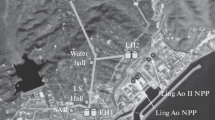Abstract
The Double Chooz experiment presents improved measurements of the neutrino mixing angle θ 13 using the data collected in 467.90 live days from a detector positioned at an average distance of 1050 m from two reactor cores at the Chooz nuclear power plant. Several novel techniques have been developed to achieve significant reductions of the backgrounds and systematic uncertainties with respect to previous publications, whereas the efficiency of the \( {\overline{\nu}}_e \) signal has increased. The value of θ 13 is measured to be sin2 2θ 13 = 0.090 + 0.032− 0.029 from a fit to the observed energy spectrum. Deviations from the reactor \( {\overline{\nu}}_e \) prediction observed above a prompt signal energy of 4 MeV and possible explanations are also reported. A consistent value of θ 13 is obtained from a fit to the observed rate as a function of the reactor power independently of the spectrum shape and background estimation, demonstrating the robustness of the θ 13 measurement despite the observed distortion.

Article PDF
Similar content being viewed by others
Avoid common mistakes on your manuscript.
References
Double CHOOZ collaboration, Y. Abe et al., Reactor electron antineutrino disappearance in the Double CHOOZ experiment, Phys. Rev. D 86 (2012) 052008 [arXiv:1207.6632] [INSPIRE].
Double CHOOZ collaboration, Y. Abe et al., First measurement of θ 13 from delayed neutron capture on hydrogen in the Double CHOOZ experiment, Phys. Lett. B 723 (2013) 66 [arXiv:1301.2948] [INSPIRE].
Double CHOOZ collaboration, Y. Abe et al., Background-independent measurement of θ 13 in Double CHOOZ, Phys. Lett. B 735 (2014) 51 [arXiv:1401.5981] [INSPIRE].
Daya Bay collaboration, F.P. An et al., Spectral measurement of electron antineutrino oscillation amplitude and frequency at Daya Bay, Phys. Rev. Lett. 112 (2014) 061801 [arXiv:1310.6732] [INSPIRE].
RENO collaboration, J.K. Ahn et al., Observation of reactor electron antineutrino disappearance in the RENO experiment, Phys. Rev. Lett. 108 (2012) 191802 [arXiv:1204.0626] [INSPIRE].
MINOS collaboration, P. Adamson et al., Electron neutrino and antineutrino appearance in the full MINOS data sample, Phys. Rev. Lett. 110 (2013) 171801 [arXiv:1301.4581] [INSPIRE].
T2K collaboration, K. Abe et al., Observation of electron neutrino appearance in a muon neutrino beam, Phys. Rev. Lett. 112 (2014) 061802 [arXiv:1311.4750] [INSPIRE].
Particle Data Group collaboration, J. Beringer et al., Review of particle physics (RPP), Phys. Rev. D 86 (2012) 010001 [INSPIRE].
C. Aberle et al., Large scale Gd-beta-diketonate based organic liquid scintillator production for antineutrino detection, 2012 JINST 7 P06008 [arXiv:1112.5941] [INSPIRE].
T. Matsubara et al., Evaluation of 400 low background 10 in. photo-multiplier tubes for the Double CHOOZ experiment, Nucl. Instrum. Meth. A 661 (2012) 16 [INSPIRE].
C. Bauer et al., Qualification tests of 474 photomultiplier tubes for the inner detector of the Double CHOOZ experiment, 2011 JINST 6 P06008 [arXiv:1104.0758] [INSPIRE].
E. Calvo et al., Characterization of large area photomutipliers under low magnetic fields: design and performance of the magnetic shielding for the Double CHOOZ neutrino experiment, Nucl. Instrum. Meth. A 621 (2010) 222 [arXiv:0905.3246] [INSPIRE].
A. Cabrera, The Double CHOOZ detector, Nucl. Instrum. Meth. A 617 (2010) 473 [INSPIRE].
K. Schreckenbach, G. Colvin, W. Gelletly and F. Von Feilitzsch, Determination of the anti-neutrino spectrum from 235 U thermal neutron fission products up to 9.5 MeV, Phys. Lett. B 160 (1985) 325 [INSPIRE].
F. Von Feilitzsch, A.A. Hahn and K. Schreckenbach, Experimental beta-spectra from 239 Pu and 235 U thermal neutron fission products and their correlated antineutrino spectra, Phys. Lett. B 118 (1982) 162 [INSPIRE].
A.A. Hahn et al., Anti-neutrino spectra from 241 Pu and 239 Pu thermal neutron fission products, Phys. Lett. B 218 (1989) 365 [INSPIRE].
A.C. Hayes, J.L. Friar, G.T. Garvey, G. Jungman and G. Jonkmans, Systematic uncertainties in the analysis of the reactor neutrino anomaly, Phys. Rev. Lett. 112 (2014) 202501 [arXiv:1309.4146] [INSPIRE].
N. Haag et al., Experimental determination of the antineutrino spectrum of the fission products of 238 U, Phys. Rev. Lett. 112 (2014) 122501 [arXiv:1312.5601] [INSPIRE].
M. Fallot et al., New antineutrino energy spectra predictions from the summation of beta decay branches of the fission products, Phys. Rev. Lett. 109 (2012) 202504 [arXiv:1208.3877] [INSPIRE].
Th.A. Mueller et al., Improved predictions of reactor antineutrino spectra, Phys. Rev. C 83 (2011) 054615 [arXiv:1101.2663] [INSPIRE].
O. Meplan et al., MURE: MCNP utility for reactor evolution — description of the methods, first applications and results, in ENC 2005: European Nuclear Conference; nuclear power for the XXIst century: from basic research to high-tech industry, (2005).
MURE, MCNP utility for reactor evolution: couples Monte-Carlo transport with fuel burnup calculations, http://www.oecd-nea.org/tools/abstract/detail/nea-1845, NEA-1845/01, (2009).
C.L. Jones et al., Reactor simulation for antineutrino experiments using DRAGON and MURE, Phys. Rev. D 86 (2012) 012001 [arXiv:1109.5379] [INSPIRE].
Y. Declais et al., Study of reactor anti-neutrino interaction with proton at Bugey nuclear power plant, Phys. Lett. B 338 (1994) 383 [INSPIRE].
J. Allison et al., GEANT4 developments and applications, IEEE Trans. Nucl. Sci. 53 (2006) 270 [INSPIRE].
GEANT4 collaboration, S. Agostinelli et al., GEANT4: a simulation toolkit, Nucl. Instrum. Meth. A 506 (2003) 250 [INSPIRE].
J.R. Granada, Slow-neutron scattering by molecular gases: a synthetic scattering function, Phys. Rev. B 31 (1985) 4167.
Y. Abe et al., The waveform digitiser of the Double CHOOZ experiment: performance and quantisation effects on photomultiplier tube signals, 2013 JINST 8 P08015 [arXiv:1307.4917] [INSPIRE].
C. Aberle, C. Buck, F.X. Hartmann, S. Schonert and S. Wagner, Light output of Double CHOOZ scintillators for low energy electrons, 2011 JINST 6 P11006 [INSPIRE].
C. Aberle, C. Buck, F.X. Hartmann and S. Schonert, Light yield and energy transfer in a new Gd-loaded liquid scintillator, Chem. Phys. Lett. 516 (2011) 257 [INSPIRE].
Double CHOOZ collaboration, Y. Abe et al., Precision muon reconstruction in Double CHOOZ, Nucl. Instrum. Meth. A 764 (2014) 330 [arXiv:1405.6227] [INSPIRE].
E.J. Axton and A.G. Bardell, Neutron yield from the spontaneous fission of \( {}^{252}Cf\left(\overline{\nu}\right) \), Metrologia 21 (1985) 59.
TRIPOLI-4 version 8.1, 3D general purpose continuous energy Monte Carlo transport code, NEA-1716/07, http://www.oecd-nea.org/tools/abstract/detail/nea-1716, (2013).
KamLAND collaboration, S. Abe et al., Production of radioactive isotopes through cosmic muon spallation in KamLAND, Phys. Rev. C 81 (2010) 025807 [arXiv:0907.0066] [INSPIRE].
Double CHOOZ collaboration, Y. Abe et al., Direct measurement of backgrounds using reactor-off data in Double CHOOZ, Phys. Rev. D 87 (2013) 011102 [arXiv:1210.3748] [INSPIRE].
MINOS collaboration, P. Adamson et al., Combined analysis of ν μ disappearance and ν μ → ν e appearance in MINOS using accelerator and atmospheric neutrinos, Phys. Rev. Lett. 112 (2014) 191801 [arXiv:1403.0867] [INSPIRE].
T2K collaboration, K. Abe et al., Precise measurement of the neutrino mixing parameter θ 23 from muon neutrino disappearance in an off-axis beam, Phys. Rev. Lett. 112 (2014) 181801 [arXiv:1403.1532] [INSPIRE].
CHOOZ collaboration, M. Apollonio et al., Limits on neutrino oscillations from the CHOOZ experiment, Phys. Lett. B 466 (1999) 415 [hep-ex/9907037] [INSPIRE].
D.A. Dwyer and T.J. Langford, Spectral structure of electron antineutrinos from nuclear reactors, arXiv:1407.1281 [INSPIRE].
Open Access
This article is distributed under the terms of the Creative Commons Attribution License (CC-BY 4.0), which permits any use, distribution and reproduction in any medium, provided the original author(s) and source are credited.
Author information
Authors and Affiliations
Consortia
Corresponding author
Additional information
ArXiv ePrint: 1406.7763
Rights and permissions
Open Access This article is distributed under the terms of the Creative Commons Attribution 4.0 International License (https://creativecommons.org/licenses/by/4.0), which permits use, duplication, adaptation, distribution, and reproduction in any medium or format, as long as you give appropriate credit to the original author(s) and the source, provide a link to the Creative Commons license, and indicate if changes were made.
About this article
Cite this article
The Double Chooz collaboration., Abe, Y., dos Anjos, J.C. et al. Improved measurements of the neutrino mixing angle θ 13 with the Double Chooz detector. J. High Energ. Phys. 2014, 86 (2014). https://doi.org/10.1007/JHEP10(2014)086
Received:
Accepted:
Published:
DOI: https://doi.org/10.1007/JHEP10(2014)086




